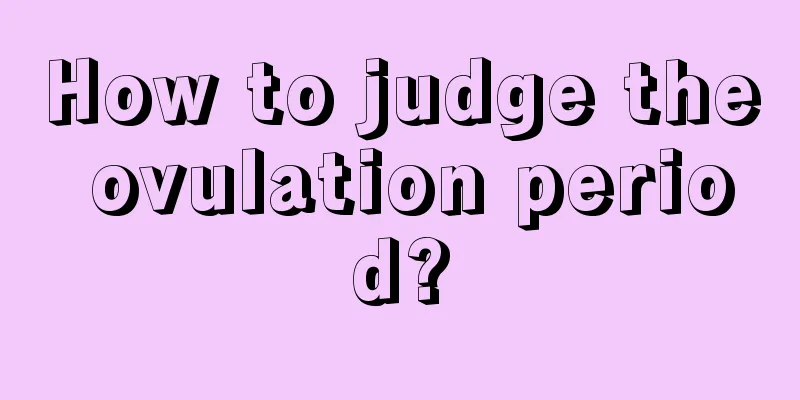How to judge the ovulation period?

|
We have many female friends who want to be mothers, but they do not have a very accurate grasp of their own physiological conditions, which leads to many problems such as how long it takes for ovulation to produce menstruation, and how to determine the ovulation period or menstrual period. If they do not have a good grasp of it, accidents are inevitable. This time we have brought you relevant information for your reference. Menstrual period calculation Many women do not know when they ovulate. Using the following formula and after a period of testing, it is easy to calculate. For normal menstrual cycles: Female ovulation is affected by endocrine hormones from the pituitary gland and ovaries and changes periodically. The length of the cycles of the two is the same, with one cycle per month, and ovulation occurs between two menstrual periods. Women's menstrual cycles vary in length, but the interval between ovulation and the start of the next menstruation is relatively fixed, usually around 14 days. Based on the relationship between ovulation and menstruation, the ovulation period can be calculated according to the menstrual cycle. The calculation method is to count from the first day of the next menstrual period, and count down 14 days or subtract 14 days to get the ovulation day. The ovulation day and the 5 days before and 4 days after the ovulation day are called the ovulation period. This is also the theoretical basis of the safe period contraceptive method, because in the menstrual cycle, except for the menstrual period and ovulation period, the rest of the time is the safe period. For example, if the menstrual cycle is 30 days, the first day of this menstruation is September 29, then the next menstruation will be on October 29 (September 29 plus 30 days), and then subtract 14 days from October 29, then October 15 is the ovulation day. The ovulation day and the 5 days before and 4 days after, that is, the ten days from October 10th to 19th are the ovulation period. To calculate the ovulation period using this method, you must first know the length of your menstrual cycle, that is, you must have a very normal or regular menstrual cycle, in order to calculate the start date of the next menstrual period and then the ovulation period. Therefore, this method is only applicable to women with normal menstrual cycles. If the menstrual cycle is irregular or abnormal, it is impossible to calculate the date of the next menstrual period, so it is impossible to calculate the ovulation day and ovulation period. For irregular menstruation, the ovulation period calculation formula is: The first day of ovulation = the number of days in the shortest menstrual cycle minus 18 days; The last day of ovulation = the longest menstrual cycle minus 11 days. For example, the shortest menstrual period is 28 days and the longest is 37 days. The shortest regular period is subtracted by 18 (28-18=10) and the longest regular period is subtracted by 11 (37-11=26). Therefore, the ovulation period is from the 10th day to the 26th day after the menstrual period. It is very important for young women to correctly grasp the ovulation period: if you want to get pregnant, start from the first day of the ovulation period and maintain a frequency of having sex every two days. If you persist for a few months, you will generally get pregnant unless there are special circumstances. Women who do not want to get pregnant need to miss having sex during these days. At this time, the ovulation period will be called another term: the dangerous period. 3 Calculation formula The first day of ovulation = the number of days in the shortest menstrual cycle minus 18 days; The last day of ovulation = the longest menstrual cycle minus 11 days. For example, the shortest menstrual period is 28 days and the longest is 37 days. The shortest regular period is subtracted by 18 (28-18=10) and the longest regular period is subtracted by 11 (37-11=26). Therefore, the ovulation period is from the 10th day to the 26th day after the menstrual period. It is very important for young women to correctly grasp the ovulation period: if you want to get pregnant, start from the first day of the ovulation period and maintain a frequency of having sex every two days. If you persist for a few months, you will generally get pregnant unless there are special circumstances. Women who do not want to get pregnant need to avoid having sex during these days. At this time, the ovulation period is called another term: the dangerous period (easy pregnancy) [1] In fact, the above information should be of some inspiration and help to female friends who are troubled in this regard. If we cannot accurately judge our ovulation period or menstrual period, then we can use the above methods and calculation formulas to estimate the exact date of our menstrual period. I hope it can help everyone. |
<<: How long does it take to get your period after induced abortion?
>>: Four types of women love to play two boats
Recommend
What should I do if I have a cough and phlegm during confinement? This care is key
During the confinement period, the newborn cannot...
Uterine maintenance techniques
Once a woman ages too quickly, she will lack conf...
Should I take Chinese medicine for regulating menstruation before or after meals?
Menstruation is a normal physiological phenomenon...
How long after abortion can I use air conditioning?
Pregnant women should try to avoid using central ...
What can pregnant women eat to cause an instant miscarriage?
Some people may become pregnant due to an acciden...
What are the effects of rhinitis in pregnant women on the fetus?
During pregnancy, most of the body becomes very f...
I took the abortion pill and vomited yellow water
In the event of an unwanted pregnancy and an unwa...
The more you eat, the more blood you bleed.
Duan Xue Liu is a blood-activating medicine commo...
Is yellowish breast milk normal?
Many people often ask, is it normal for breast mi...
Is it good for pregnant women to eat carp?
Pregnant women refer to women who are pregnant. T...
Headaches in early pregnancy
Women will experience symptoms of drowsiness and ...
Is your skin getting drier? Don’t make these hydration and moisturizing mistakes!
Skin is the largest organ in our body. It exists ...
What is the purpose and significance of reading? Why should women read?
Through reading, you can not only learn how to so...






![[Creative Cultivation Program] Research found that eating spicy food has so many benefits, you definitely don’t know these 6!](/upload/images/67f1d6f4bb96a.webp)


